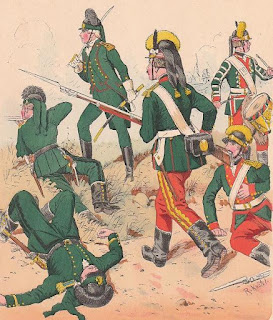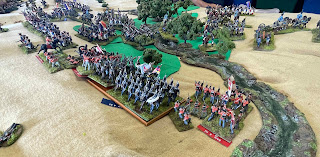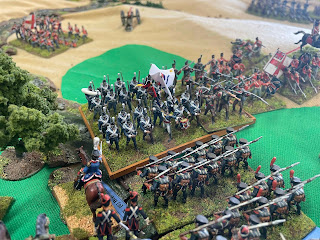Serendipity, my great friend, combined to provide a real treat for me yesterday, on the occasion of the 202nd anniversary of the death of Napoleon.
It began a few days ago with one of the many marketing emails that I receive. I'm foolish enough to be on several such mailing lists but generally show discipline and self-control. On this occasion two offerings, Accusé Napoléon, Levez-Vous!, an historic judgement of Napoleon written by a famous (apparently), contemporary French judge, and Souvenirs De La Campagne De Russie En 1812, the memoir of Adrien De Mailly of the 2nd carabiniers, were both well priced and, once I had checked out a precis of each on Napoleon.org, attractive enough to purchase. Given what was to follow, it is interesting to note that the first book was originally published in 2021 to mark the occasion of the bicentennial of Napoleon's death.
Anyway, this lead to a bit of looking around at other titles, and one particularly caught my eye. It is entitled From Valmy to Waterloo France at War, 1792-1815 by Marie-Cécile Thoral and has been published as a translation by Springer Link. I have added it to my wish list. While looking for more information about this book I 'stumbled' on William Keyser's eponymous rules.
Published in 1995, I had a vague recollection that I had seen them, many years ago. Timing is everything in life and, while they may not have grabbed my attention back then, I am now at a stage where my 'focus' and interests mean that I am open to wide and varied sets of rules and particularly interested in anything that bucks the modern trend for simple, fast-play mechanics.
Comments like,
"Rules are somewhat complex, but once mastered give an accurate picture of conflict in the time period."
and
"I found a lot of Valmy frustrating at first, but once we mastered the rules, my group found that a lot of "Oh, yeah! That's how it works!" were being declared. Things started to make sense, and we also found that using the historical tactics made things come together." ...
had me looking to get a copy.
This was not as easy as I expected. They are now out of print with the publisher and the only second hand copies that I could find were commanding the sort of prices that a 'collector' might pay. I did not want them that much!
In looking for info. about them I had found that William Keyser is working on a second edition, to include a pdf version. My experience with second editions of rules mean that I'd prefer the original, but, I decided that would have to do (and would be more within the budget of what I'm prepared to pay). He had hoped to have the second edition available by late 2021. Ah well, I may have to wait a while. No matter.
Then I had a recollection.
Looking at images of the cover, I was sure that I had seen them in Tactics, the wonderful wargaming shop in Perth. Did I recall correctly and, if so, would they still be there? Tactics is a wonderland. You can lose yourself browsing in there for hours, finding something new or some old gem that is hidden amongst the mass of material that they keep in a small shop. They stock the latest and greatest, stuff that interests the 'kids' but also have more conventional wargaming supplies and materials, although the things that appeal to me seem to be largely confined to one little corner! One of the many wonderful things about the shop is that they don't clear out old stock, it just seems to be tucked away in a nook somewhere as new, shiny offerings are introduced and take prime of place. Anyway, I sent an email to Jason asking if they had a copy of From Valmy to Waterloo, mentioning that I recalled seeing it in the shop many years ago.
I received a most encouraging response.
"We do seem to have it. I say seem because we have a set mostly shrink wrapped, and a couple of bits and pieces separately that seem to partly duplicate the set. Anyway, I have put them aside for you. I can do the whole lot for $20."
Marvellous, I thought. Not only had I not imagined the memory, they were still there and I could get them for a most reasonable price. I had to go to Perth for work on Friday, so could collect them in the arvo'. Friday was 5th May, the anniversary of the death of Napoleon, 202 years ago.
When I got to the shop, the news seemed even better than I had hoped. Not only did it seem that there was a full set, in torn shrink-wrapping with minor 'shop soiling' (slightly faded cover), but what Jason had referred to as 'bits and pieces' seemed to include a second copy of the rules. I had a chance on the train from the city back to Midland where my car was parked for the drive home to the country to look over the rules and to read the first chapter. I was really pleased by what I read. No 'buyers regret'!
 |
| There is a lot included in the complete package. Nice production qualities with a focus on content and not the colour pictures and other glitz that seems a requirement of rules of today, and all too often seems to be purely 'window dressing'. |
My delight increased once I got home and could look in more detail and more carefully at what I had. There was, indeed, a complete copy of the entire 'package' in that torn shrink wrap: the booklet of rules, a 'compendium' booklet which outlines the basics of the rules (scales, basing, the components in the game package, unit ratings, movement rates, formations) as well as army lists and four scenarios, a spiral-bound booklet of reference sheets, four sheets of card with examples of unit cards (for the scenarios, a blank template being provided at the back of the compendium), templates for artillery fire, templates for order sheets and two sheets of counters of markers for the game. Added to this, the 'bits and pieces' as Jason had referred to them were actually a second copy of the booklet of rules, compendium, reference sheets, one of the templates for artillery fire and two of the sheets of example unit cards. I copied the 'missing' parts from the original et voilà; a second, complete set. I'll keep the original as pristine as possible and work with the set of originals and copied components.
I have now read some more of the rules and am liking what I read. Detail, clarity and focus on historical aspects. I am also enjoying the approach of having the rules spread across three books/booklets. As William Keyser states in his introduction, the aim is that the player uses the reference sheets ('cheat sheets' as he refers to them) during game play, only referring to the rules to clarify or obtain detail about a particular rule.
There is a lot that is Empire-esque, corps orders that prescribe and proscribe divisional orders, and detail of the requirements of units and formations according to orders, but a lot is different too. A turn is set at 15 minutes, almost harking back to the rules of the 70s. Grand tactical aspects (chiefly meaning actions of senior command) are separated from the tactical ones. "On the tactical level the gamer is placed in the role of the Brigade Commander and must accomplish the tasks that are given to him by his superiors" (p. ii).
I like the impression that I am getting of the mechanics, based on what I have read and from flicking to and fro through the rules. Combining army/corps with more detailed tactical aspects, a focus on higher level formations as well as manoeuvring of individual battalions, regiments and batteries, the importance of combined arms, the need for attack and defence in depth, clear rules for passage of lines to relieve front-line units, national characteristics and changes to same over the course of the wars, morale at the centre of charge, mêlée and firefight procedures, separation of morale and training (quality), cavalry mass and wave attacks, to list a few. The way the reference sheets, rule book and compendium combine to provide what is needed to set up a game (compendium), go through turns (reference sheets) and refer to details (rules) also appeals to me.
 |
The reference sheets show the detail in each test, but they are laid out clearly, showing how to move from one to the next and with references to appropriate page numbers in the rules for explanations.
|
 |
The rules are dense but each section (which is clearly labelled with a black rectangle at the edge of the page) begins with a description of the rule in question, followed by details for each aspect or modifier involved. The information about the point/aspect/modifier is succinct and clear. Paragraphing and the use of bold text helps to identify particular points for each area of the rules.
|
A couple of other bonuses add to the initial positives from my perspective. All distances and ranges in the rules are given in metres. Firstly I am pleased and impressed that a set of rules from the US was progressive enough to use metric, but secondly because it makes scaling a simple exercise. Figure basing is described for 5 mm, 10 mm and 15 mm figures only (adding to my perception that William Keyser was ahead of his time), but any scale of figures and basing can be used according to a preferred figure and ground scale. The rules will be excellent for solo play because of the way the orders prescribe and proscribe the types of actions that formations and units can undertake. The detail and I expect time involved in each turn will lend itself to playing out a game over a number of sessions, which is my preferred modus operandi. A scenario for Quatre Bras is one of the four in the compendium. No great surprise that it was chosen, but good for me as it is the battle that I am using in my on-going evaluation of sets of rules.
There is a lot of material to come to grips with but I am enjoying the exploration.
Happy as a pig in the proverbial.

































































































